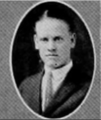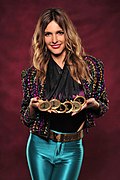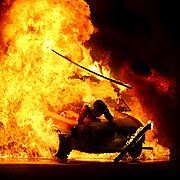Our website is made possible by displaying online advertisements to our visitors.
Please consider supporting us by disabling your ad blocker.
Portal:Television
The Television Portal

Television (TV) is a telecommunication medium for transmitting moving images and sound. Additionally, the term can refer to a physical television set rather than the medium of transmission. Television is a mass medium for advertising, entertainment, news, and sports. The medium is capable of more than "radio broadcasting," which refers to an audio signal sent to radio receivers.
Television became available in crude experimental forms in the 1920s, but only after several years of further development was the new technology marketed to consumers. After World War II, an improved form of black-and-white television broadcasting became popular in the United Kingdom and the United States, and television sets became commonplace in homes, businesses, and institutions. During the 1950s, television was the primary medium for influencing public opinion. In the mid-1960s, color broadcasting was introduced in the U.S. and most other developed countries.
In 2013, 79% of the world's households owned a television set. The replacement of earlier cathode-ray tube (CRT) screen displays with compact, energy-efficient, flat-panel alternative technologies such as LCDs (both fluorescent-backlit and LED), OLED displays, and plasma displays was a hardware revolution that began with computer monitors in the late 1990s. Most television sets sold in the 2000s were still CRT, it was only in early 2010s that flat-screen TVs decisively overtook CRT. Major manufacturers announced the discontinuation of CRT, Digital Light Processing (DLP), plasma, and even fluorescent-backlit LCDs by the mid-2010s. LEDs are being gradually replaced by OLEDs. Also, major manufacturers have started increasingly producing smart TVs in the mid-2010s. Smart TVs with integrated Internet and Web 2.0 functions became the dominant form of television by the late 2010s.[better source needed] (Full article...)
Selected article -
In 1969, the children's television show Sesame Street premiered on the National Educational Television network (later succeeded by PBS) in the United States. Unlike earlier children's programming, the show's producers used research and over 1,000 studies and experiments to create the show and test its impact on its young viewers' learning. By the end of the program's first season, Children's Television Workshop (CTW), the organization founded to oversee Sesame Street production, had developed what came to be called "the CTW model": a system of planning, production, and evaluation that combined the expertise of researchers and early childhood educators with that of the program's writers, producers, and directors.
CTW conducted research in two ways: in-house formative research that informed and improved production, and independent summative evaluations conducted by the Educational Testing Service (ETS) during the show's first two seasons to measure the program's educational effectiveness. CTW researchers invented tools to measure young viewers' attention to the program. Based on these findings, the researchers compiled a body of data and the producers changed the show accordingly.
Selected image -

A satellite dish is a type of parabolic antenna designed with the specific purpose of transmitting signals to and/or receiving from satellites. A satellite dish is a particular type of microwave antenna. Satellite dishes come in varying sizes and designs, and are most commonly used to receive satellite television.
Did you know (auto-generated) -

- ... that Ruslana Pysanka, who hosted a Ukrainian television program with Volodymyr Zelenskyy, died as a refugee in Germany?
- ... that among the special events broadcast by the Maine Television Network during its brief existence were a fashion show, a basketball tournament, and an ordination ceremony?
- ... that when Florida television station WITV ceased broadcasting in May 1958, its owner was reported to be on a yacht at sea and thus unavailable for comment?
- ... that in 1982, a news anchor for Phoenix television station KOOL-TV was held hostage on set for five hours?
- ... that the ending of the TV series Community features a fourth-wall-breaking monologue?
- ... that the Fox television network successfully moved to strip an Iowa TV station of its affiliation?
Selected quote -
More did you know
- ...that the title of Dan Castellaneta's album of comedy sketches I Am Not Homer is a parody of Leonard Nimoy's first autobiography I Am Not Spock?
- ...that The O.C.'s music supervisor Alexandra Patsavas worked in the music department of over fifty Roger Corman B-movies before her television debut?
- ...that model Albert Reed, selected to appear in September 2007 on the United States television show Dancing with the Stars, admits that he cannot dance?
- ..that the time traveling premise featured in the Chrono series of video games was inspired by such television programs as The Time Tunnel?
- ...that Russian television implied that Filipp Kirkorov won the Eurovision Song Contest 1995 with "Kolibelnaya Dlya Vulkana" when he in fact only came 17th?
Selected biography -
Daniel Irvin Rather Jr. (/ˈræðər/; born October 31, 1931) is an American journalist, commentator, and former national evening news anchor. He began his career in Texas, becoming a national name after his reporting saved thousands of lives during Hurricane Carla in September 1961. In his first national broadcast, he helped initiate the successful evacuation of 350,000 people. He reported on some of the most significant events of the modern age, such as the fall of the Berlin Wall, the Gulf War, 9/11, the Iraq War, and the war on terror.
Rather also famously reported from Dallas in November 1963 at the time that President John F. Kennedy had been assassinated. Based on such reporting, he was promoted at CBS News, where he served as White House correspondent beginning in 1964. He served as foreign correspondent in London and Vietnam over the next two years before returning to the White House correspondent position. He covered the presidency of Richard Nixon, including Nixon's trip to China, the Watergate scandal, and the president's resignation. (Full article...)
General images
News
- December 28: US professional wrestler Jon Huber dies aged 41
- September 2: Tributes paid to recently deceased US actor Chadwick Boseman
- May 24: Japanese professional wrestler and Netflix star Hana Kimura dies aged 22
- January 16: BBC newsreader Alagiah to undergo treatment for bowel cancer
- Upcoming events
Featured content
Main topics
History of television: Early television stations • Geographical usage of television • Golden Age of Television • List of experimental television stations • List of years in television • Mechanical television • Social aspects of television • Television systems before 1940 • Timeline of the introduction of television in countries • Timeline of the introduction of color television in countries
Inventors and pioneers: John Logie Baird • Alan Blumlein • Walter Bruch • Alan Archibald Campbell-Swinton • Allen B. DuMont • Philo Taylor Farnsworth • Charles Francis Jenkins • Boris Grabovsky • Paul Gottlieb Nipkow • Constantin Perskyi • Boris Rosing • David Sarnoff • Kálmán Tihanyi • Vladimir Zworykin
Technology: Comparison of display technology • Digital television • Liquid crystal display television • Large-screen television technology • Technology of television
Terms: Broadcast television systems • Composite monitor • HDTV • Liquid crystal display television • PAL • Picture-in-picture • Pay-per-view • Plasma display • NICAM • NTSC • SECAM
Categories
WikiProjects

|
You are invited to participate in WikiProject Television, a WikiProject dedicated to developing and improving articles about Television. |
- Main projects
- Sub-projects
Television Stations • American animation • American television • Australian television • British TV • BBC • Canadian TV shows • Television Game Shows • ITC Entertainment Productions • Digimon • Buffyverse • Doctor Who • Degrassi • EastEnders • Episode coverage • Firefly • Futurama • Grey's Anatomy • Indian television • Lost • Nickelodeon • The O.C. • Professional Wrestling • Reality TV • The Simpsons • Seinfeld • South Park • Stargate • Star Trek • Star Wars • Soap operas • Avatar: The Last Airbender • House
- Related projects
Animation • Anime and manga • Comedy • Comics • Fictional characters • Film • Media franchises
What are WikiProjects?
Things you can do

- Place the {{WikiProject Television}} project banner on the talk pages of all articles within the scope of the project.
- Write: Possible Possum
- Cleanup: color television, Alien Nation: Body and Soul, The Sopranos, Alien Nation: Dark Horizon, Alien Nation: The Enemy Within, Alien Nation: Millennium, Aang
- Expand: Timeline of the introduction of color television in countries
- Stubs: Flow (television), Just for Kicks (TV series), Play of the Month, Nova (Dutch TV series), More stubs...
Subportals
Related portals
Associated Wikimedia
The following Wikimedia Foundation sister projects provide more on this subject:
-
Commons
Free media repository -
Wikibooks
Free textbooks and manuals -
Wikidata
Free knowledge base -
Wikinews
Free-content news -
Wikiquote
Collection of quotations -
Wikisource
Free-content library -
Wikiversity
Free learning tools -
Wiktionary
Dictionary and thesaurus
Previous Page Next Page





































































